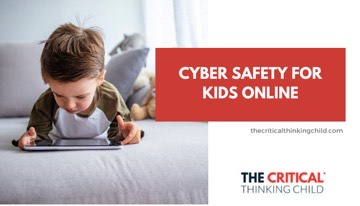October is National Cyber Security Month, and with more and more of our lives and schooling shifting online, cyber safety for kids is more important than ever. According to a 2016 Children’s Internet Usage Study conducted by the Center for Cyber Safety and Education, about two-thirds of fourth to eighth graders have access to phones or tablets.
Here at The Critical Thinking Child, we’re on the front lines of helping young learners understand how to safely interact with technology. In fact, we just released an all new picture book series about Cyber City, where kids learn about everything from smartphone etiquette to making passwords.
Here’s what you need to know as we head into Cyber Safety Month.
Cyber Safety Month
The CISA (Cybersecurity and Infrastructure Security Agency) has designated each week in October to a different issue of cyber safety:
Week of October 5 (Week 1): If You Connect It, Protect It
Week of October 12 (Week 2): Securing Devices at Home and Work
Week of October 19 (Week 3): Securing Internet-Connected Devices in Healthcare
Week of October 26 (Week 4): The Future of Connected Devices
Many of these topics, particularly issues of connectivity and security at home, can help families with e-learning for kids.
Cyber Safety Tips for Families
We typically think of cybersecurity as an issue for adults only, like protecting our credit card information and social security number. However, with the increase of e-learning for kids, issues of security are cropping up in all parts of the school day.
- Emphasize password protection: First and foremost, students need to be aware of issues around password security. They should be taught to never give away their password, and older kids can be taught how to choose a secure password.
- Use appropriate websites: It’s also essential to talk to your kids about safe and appropriate websites. During e-learning, stick with the websites and tech tools that your child’s teacher is using. These are usually safe, secure sites that may have even been purchased by the school district to be password protected.
- Stay anonymous: Beyond this, students should learn rules for using smartphones, tablets, and other devices safely. Be sure to stress the importance of never giving out identifying information like a full name or address online.
- Be kind: In these times of virtual everything, character still matters. Remind your child to always treat people kindly (even from behind a screen) and avoid cyberbullying.
- Avoid viruses: If not used correctly, devices can be taken over by viruses and malware. To prevent this, be sure to download a secure anti-virus software and remind your child never to click on pop-up ads that may invite viruses.
Open communication with your children around issues of cyber safety is crucial. Make sure your child knows that they can come to you if they encounter something confusing or unsafe online, and regularly revisit rules around technology. And make it fun! Check out the Cyber City books for an easy, accessible way to talk about these ideas.
We’re committed to cyber safety for children
Here at the Critical Thinking Child, we have chosen to join the National Cyber Security Alliance, a cyber safety campaign aimed at educating and empowering the public about cyber security. We are passionate about empowering parents with the tools and resources they need to help kids build healthy cyber safety habits.
The digital world isn’t going anywhere, and it’s so important for parents and teachers to start teaching these valuable skills from a young age. That way, learners can embrace the advantages of technology without falling victim to its shortcomings. We’re committed to playing an active role in these conversations.
If you’re interested in some fun, readable books on cyber safety for kids, our new books on cyber safety are now available! Head on over to meet Digital Dan and his friends.
Sources Used:
https://www.consumernotice.org/data-protection/internet-safety-for-kids/



